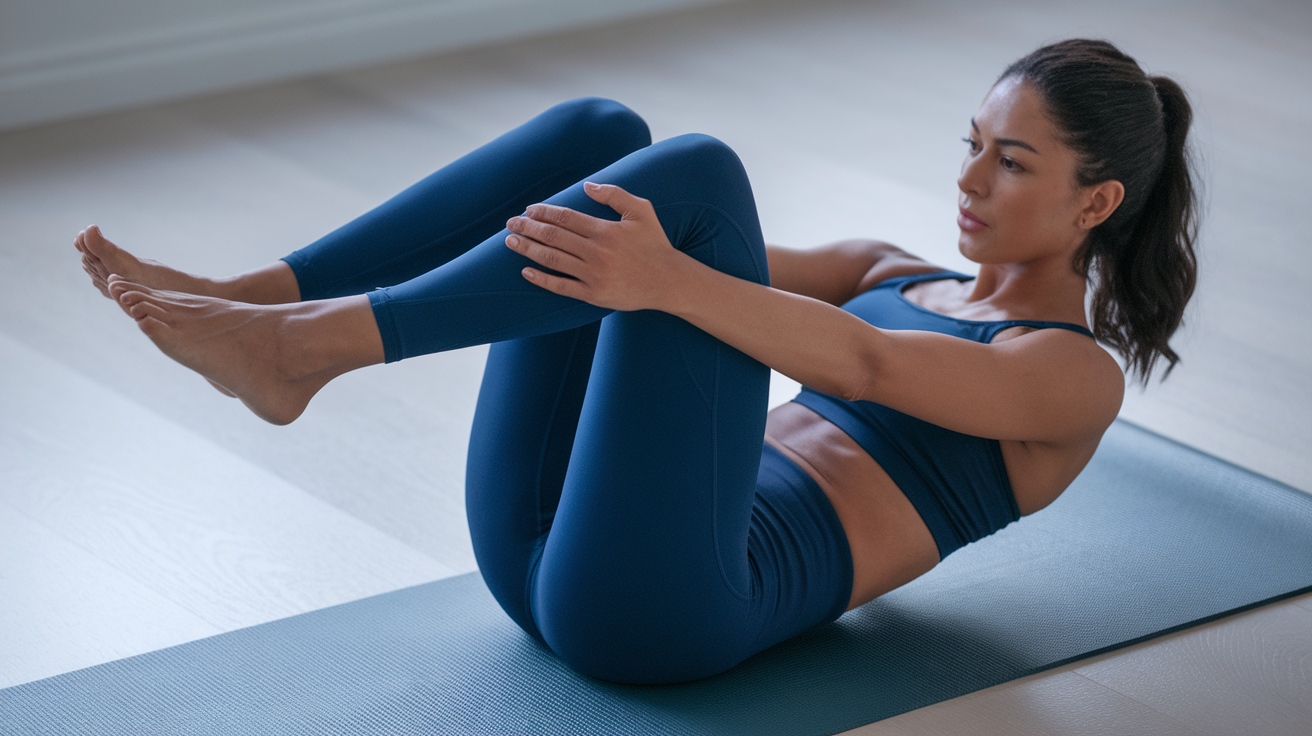A strong core is essential for women’s overall health and fitness. It’s not just about achieving a flat stomach; a well-developed midsection improves posture, reduces back pain, and enhances athletic performance. Many women find it challenging to maintain a consistent gym routine due to busy schedules or other commitments. Fortunately, effective ab workouts can be done right at home, without any expensive equipment.
At-home ab workouts offer numerous advantages for women looking to strengthen their core. They’re convenient, time-efficient, and can be easily incorporated into daily routines. These exercises often require little to no equipment, making them accessible to everyone, regardless of fitness level or budget. Plus, working out in the comfort of your own space can boost confidence and eliminate self-consciousness that some might feel in a gym setting.
The following sections will share five effective ab workouts that women can try at home for a flatter stomach. These routines range from plank variations and bodyweight exercises to dynamic moves, yoga-inspired poses, and high-intensity interval training (HIIT). Each workout targets different aspects of core strength, helping to create a well-rounded and effective ab-sculpting routine. Keep reading to discover how you can transform your core without leaving your living room.
- What Makes an Effective Ab Workout for Women?
- Workout 1: Plank Variations for a Strong Core
- How Can Bodyweight Exercises Target Abs?
- Workout 3: Dynamic Moves for a Full Ab Burn
- Can Yoga-Inspired Moves Flatten Your Stomach?
- Workout 5: HIIT for Maximum Ab Definition
- Sculpting Your Core: The Path to a Flatter Stomach
- Frequently Asked Questions
What Makes an Effective Ab Workout for Women?
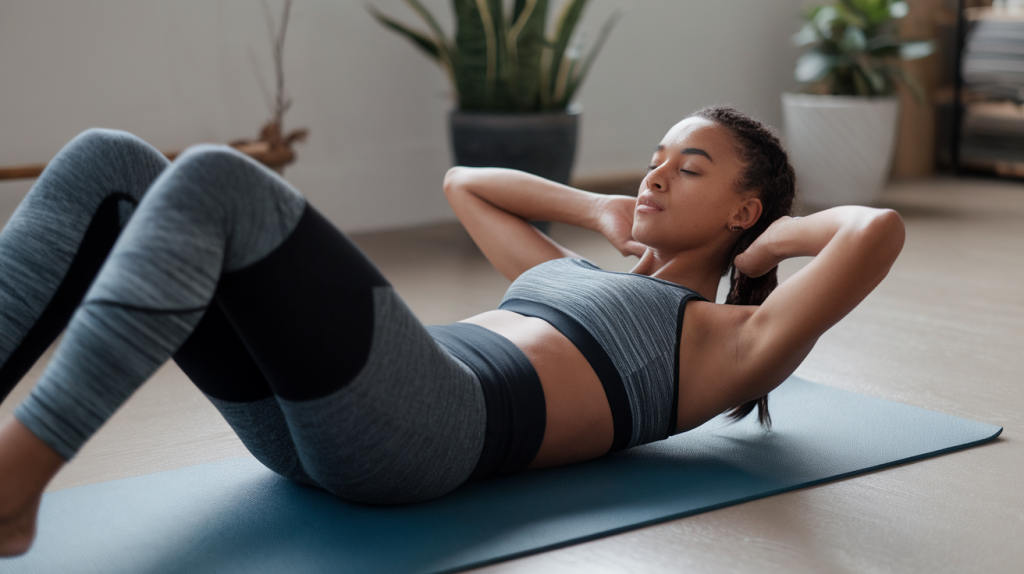
Creating an effective ab workout for women involves more than just doing endless crunches. A well-rounded approach targets all core muscle groups, emphasizes proper form, and combines various exercise types. Let’s explore what makes an ab workout truly effective for women aiming to achieve a flatter stomach.
Targeting all core muscle groups
Your core is made up of several muscle groups, not just the “six-pack” abs you see on the surface. An effective workout should engage all of these muscles:
- Rectus abdominis (the “six-pack” muscles)
- Obliques (side abs)
- Transverse abdominis (deep core muscles)
- Lower back muscles
By incorporating exercises that work these different areas, you’ll develop a stronger, more balanced core. This not only helps create a flatter appearance but also improves overall stability and posture.
Importance of proper form and technique
How you perform an exercise is just as important as which exercise you choose. Proper form ensures you’re targeting the right muscles and reduces the risk of injury. When doing ab exercises, keep these tips in mind:
- Engage your core throughout the entire movement
- Avoid pulling on your neck during crunches
- Keep your lower back pressed against the floor during leg raises
- Breathe steadily and avoid holding your breath
If you’re unsure about your form, consider working with a fitness professional or watching tutorial videos to perfect your technique.
Frequency and duration recommendations
How often should you work your abs? The answer might surprise you. Unlike other muscle groups that need more recovery time, your core can handle more frequent workouts. Aim to include ab exercises in your routine 3-4 times a week.
As for duration, quality trumps quantity. A focused 10-15 minute ab workout can be highly effective if done correctly. Remember, your abs also get worked during other exercises like squats and push-ups, so they’re often engaged even when you’re not specifically targeting them.
Combining cardio with strength training
While targeted ab exercises are important, they’re not the only key to a flatter stomach. Combining strength training with cardio can help you burn fat while building muscle, leading to more visible ab definition.
High-intensity interval training (HIIT) is particularly effective for this. It alternates short bursts of intense exercise with periods of rest or lower-intensity activity. This type of workout can help you burn calories and fat more efficiently than steady-state cardio alone.
Nutrition’s role in achieving a flatter stomach
You’ve probably heard the saying, “Abs are made in the kitchen,” and there’s a lot of truth to it. No amount of exercise can outwork a poor diet. To reveal your ab muscles, you need to reduce overall body fat, which is largely influenced by what you eat.
Focus on a balanced diet rich in:
- Lean proteins
- Whole grains
- Fruits and vegetables
- Healthy fats
Avoid processed foods, excess sugar, and alcohol, as these can contribute to bloating and fat storage around the midsection.
Staying hydrated is also crucial. Water helps flush out toxins, reduce bloating, and keep your metabolism running smoothly. Aim for at least 8 glasses of water a day.
Creating an effective ab workout for women isn’t just about doing the right exercises. It’s about taking a holistic approach that includes targeting all core muscles, maintaining proper form, combining different types of exercise, and supporting your efforts with good nutrition. By following these principles, you’ll be on your way to developing a stronger, flatter stomach.
Workout 1: Plank Variations for a Strong Core
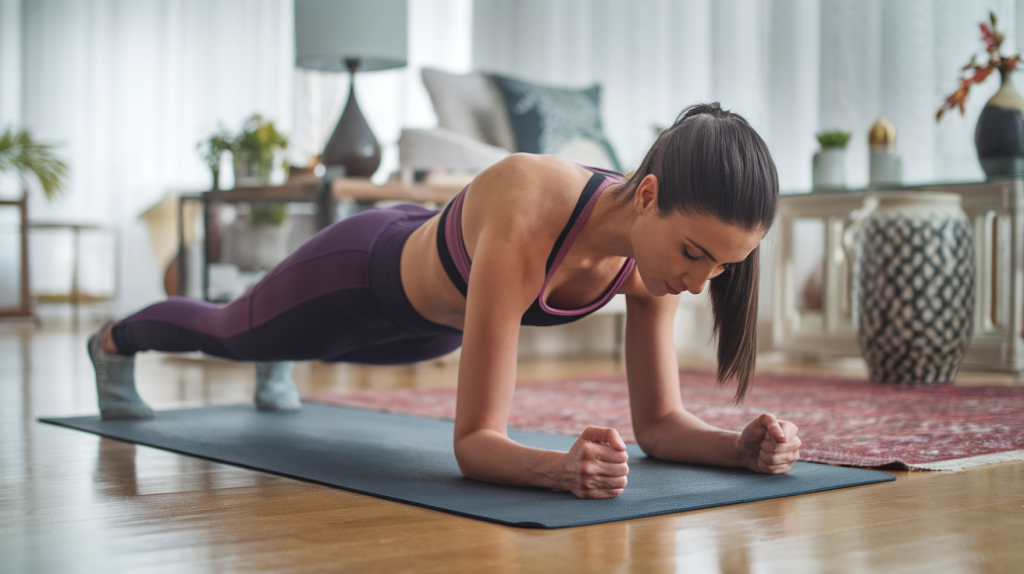
Planks are a powerhouse exercise for building core strength. They engage multiple muscle groups simultaneously, making them an efficient choice for women seeking to tone their midsection. Let’s explore five plank variations that can help you achieve a stronger core without leaving your home.
Standard forearm plank
The foundation of all plank exercises, the standard forearm plank, is deceptively simple yet incredibly effective. To perform this exercise:
- Start by lying face down on the floor.
- Prop yourself up on your forearms, keeping your elbows directly under your shoulders.
- Lift your body off the ground, forming a straight line from your head to your heels.
- Engage your core by pulling your belly button towards your spine.
- Hold this position for 30 seconds to 1 minute, or as long as you can maintain proper form.
Why is this exercise so beneficial? It targets your entire core, including your rectus abdominis, obliques, and transverse abdominis. Plus, it engages your back, shoulders, and legs, making it a full-body workout.
Side plank with hip dips
Ready to challenge your obliques? The side plank with hip dips is an excellent variation that targets your waist and helps create that coveted hourglass figure.
To perform this exercise:
- Start in a side plank position, resting on your forearm with your elbow directly under your shoulder.
- Stack your feet or stagger them for more stability.
- Lift your hips off the ground, creating a straight line from your head to your feet.
- Slowly lower your hip towards the ground, then lift it back up.
- Repeat this dipping motion 10-15 times on each side.
This exercise not only works your obliques but also improves your balance and stability.
Plank jacks
Want to add some cardio to your plank routine? Plank jacks are the perfect solution. They combine the core-strengthening benefits of a plank with the cardiovascular boost of jumping jacks.
Here’s how to do them:
- Start in a standard plank position with your hands directly under your shoulders.
- Jump your feet out to the sides, as you would in a jumping jack.
- Quickly jump your feet back together.
- Repeat this movement for 30 seconds to 1 minute.
Plank jacks elevate your heart rate while maintaining constant engagement in your core muscles. They’re an excellent way to burn calories and build endurance.
Mountain climber planks
Mountain climber planks are a dynamic exercise that targets your abs while also working your hip flexors and shoulders. They’re particularly effective for developing lower abdominal strength.
To perform mountain climber planks:
- Begin in a high plank position with your hands directly under your shoulders.
- Bring your right knee towards your chest, then quickly switch and bring the left knee in as the right leg extends back.
- Continue alternating legs in a running motion.
- Maintain a strong plank position throughout the movement, keeping your hips low and your core engaged.
Aim for 30 seconds to 1 minute of continuous movement. As you become stronger, you can increase the speed for a more intense workout.
Plank to downward dog
This exercise combines the core-strengthening benefits of a plank with the stretching and flexibility advantages of the yoga pose, downward dog. It’s an excellent way to work your entire body while also improving your mobility.
Follow these steps:
- Start in a high plank position.
- Keeping your hands and feet stationary, lift your hips up and back, forming an inverted V shape with your body.
- Hold the downward dog position for a moment, feeling the stretch in your hamstrings and calves.
- Slowly lower back into the plank position.
- Repeat this movement 10-15 times.
This exercise not only works your core but also stretches your back and leg muscles, promoting better overall flexibility and posture.
Incorporating these plank variations into your workout routine can significantly boost your core strength. Start with shorter hold times and fewer repetitions, gradually increasing as your strength improves. Remember, consistency is key. Regular practice of these exercises, combined with a balanced diet, can help you achieve that strong, toned midsection you’re aiming for.
How Can Bodyweight Exercises Target Abs?
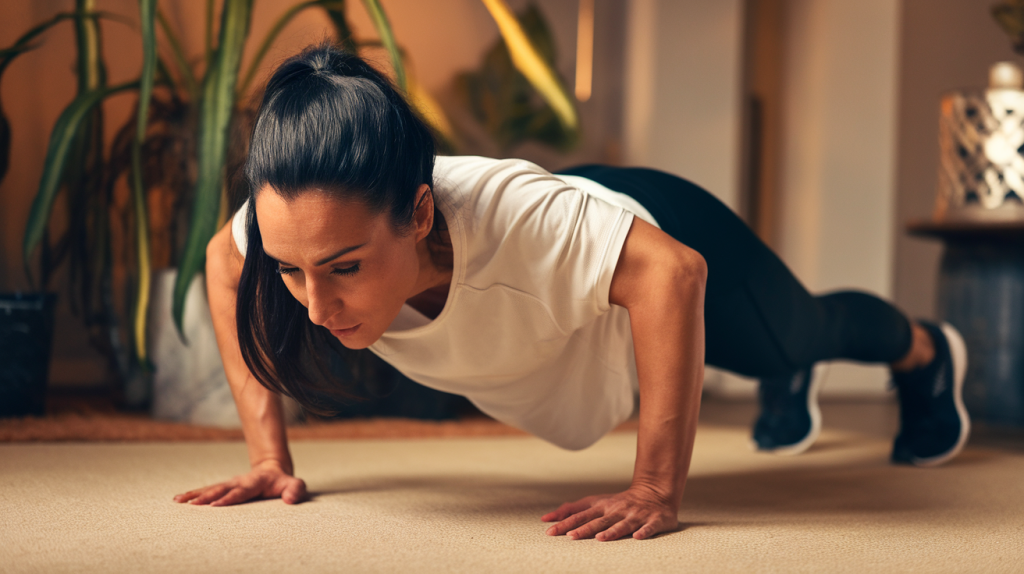
Bodyweight exercises are a powerful tool for targeting your abs, requiring no equipment and minimal space. These exercises use your own body as resistance, making them perfect for at-home workouts. Let’s explore five effective bodyweight exercises that can help you sculpt and strengthen your core.
Bicycle crunches
Bicycle crunches are a dynamic exercise that targets multiple areas of your abs simultaneously. They work your rectus abdominis (the “six-pack” muscles) and your obliques (side abs).
To perform bicycle crunches:
- Lie on your back with your hands behind your head
- Lift your shoulders off the ground and bring your right elbow towards your left knee
- Simultaneously extend your right leg
- Switch sides, bringing your left elbow to your right knee while extending your left leg
- Continue alternating sides in a pedaling motion
Aim for 3 sets of 15-20 repetitions on each side. The key to making this exercise effective is to move slowly and deliberately, focusing on the contraction of your abdominal muscles.
Russian twists
Russian twists are excellent for working your obliques and improving rotational strength in your core. This exercise also engages your hip flexors and lower back muscles.
Here’s how to do Russian twists:
- Sit on the floor with your knees bent and feet flat
- Lean back slightly, keeping your back straight
- Lift your feet off the ground (for beginners, keep your feet on the ground)
- Clasp your hands together in front of your chest
- Rotate your torso to the right, then to the left
Perform 3 sets of 20-30 total rotations (10-15 per side). As you get stronger, you can add a weight or medicine ball for extra resistance.
Leg raises
Leg raises primarily target your lower abs, an area many women find challenging to tone. They also engage your hip flexors and help improve lower back strength.
To perform leg raises:
- Lie on your back with your legs straight and arms at your sides
- Keep your legs together and lift them straight up towards the ceiling
- Slowly lower your legs back down, stopping just before they touch the ground
- Lift them back up to complete one repetition
Try to complete 3 sets of 10-15 repetitions. If you find this too challenging, you can bend your knees slightly or only lower your legs partway down.
V-ups
V-ups are an advanced exercise that targets your entire core, including your upper and lower abs, obliques, and hip flexors. They also improve your balance and coordination.
Follow these steps for V-ups:
- Lie on your back with your arms extended overhead and legs straight
- Simultaneously lift your arms and legs off the ground, reaching your hands towards your toes
- Your body should form a “V” shape at the top of the movement
- Lower back down to the starting position
Start with 3 sets of 8-10 repetitions. This exercise is quite challenging, so don’t be discouraged if you can’t do many at first. Focus on proper form and gradually increase your reps as you get stronger.
Reverse crunches
Reverse crunches are particularly effective for targeting the lower abs. They’re a great alternative to traditional crunches and can be easier on your neck and back.
Here’s how to do reverse crunches:
- Lie on your back with your knees bent and feet flat on the floor
- Place your arms at your sides, palms down
- Lift your feet off the ground, bringing your knees directly over your hips
- Curl your hips off the ground, bringing your knees towards your chest
- Slowly lower back to the starting position
Aim for 3 sets of 12-15 repetitions. Remember to breathe steadily throughout the exercise and focus on using your abs to lift your hips, not momentum.
These bodyweight exercises offer a comprehensive ab workout that you can do anywhere, anytime. The key to seeing results is consistency and proper form. Start with 2-3 sessions per week, gradually increasing the frequency and intensity as your strength improves. Remember, visible abs also depend on overall body fat percentage, so combine these exercises with a balanced diet and regular cardio for best results.
Workout 3: Dynamic Moves for a Full Ab Burn
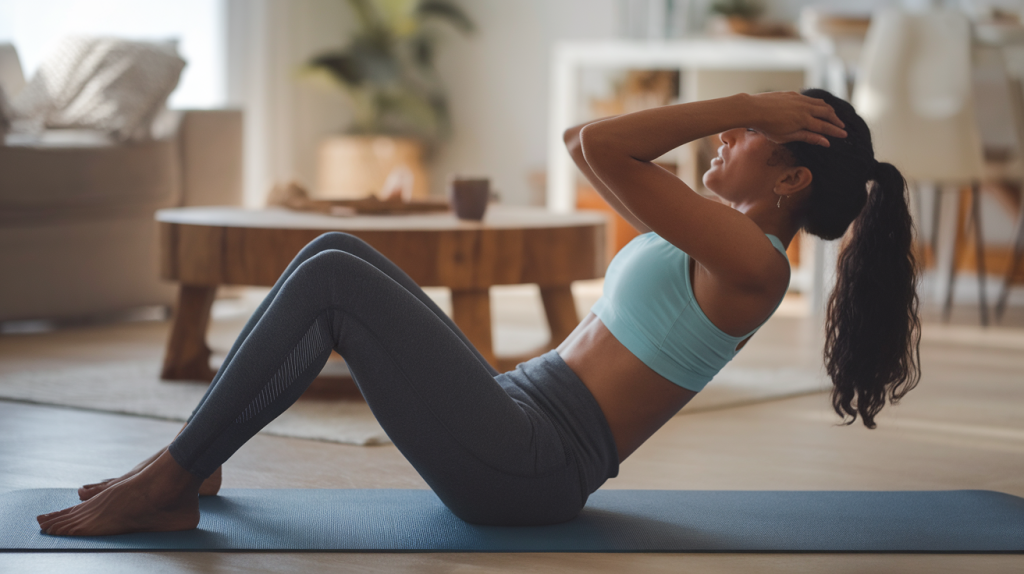
Dynamic moves are a game-changer for women seeking a full ab burn. These exercises combine cardio and strength training, targeting your core while elevating your heart rate. Let’s explore five powerful moves that will set your abs on fire.
Burpees
Burpees are a full-body exercise that engages your core throughout the entire movement. They’re challenging but highly effective for burning calories and toning your midsection.
How to perform a burpee:
- Start in a standing position
- Drop into a squat and place your hands on the floor
- Kick your feet back into a plank position
- Do a push-up (optional for added difficulty)
- Jump your feet back to your hands
- Explode upward into a jump, reaching your arms overhead
Aim for 3 sets of 10-15 repetitions. If you’re new to burpees, start with fewer reps and focus on maintaining proper form.
Jumping jack planks
This exercise combines the core-strengthening benefits of a plank with the cardio boost of jumping jacks. It’s an excellent way to engage your entire core while also working on your coordination.
To perform jumping jack planks:
- Start in a high plank position
- Jump your feet out wide, as you would in a jumping jack
- Immediately jump your feet back together
- Repeat this movement for 30-45 seconds
Try to complete 3 sets, with a short rest between each set. As you get stronger, you can increase the duration of each set.
Spiderman push-ups
Spiderman push-ups target your chest, shoulders, and triceps while also engaging your core and obliques. They’re a more advanced move, so don’t worry if you need to modify at first.
Here’s how to do a Spiderman push-up:
- Start in a high plank position
- As you lower your body into a push-up, bring your right knee towards your right elbow
- Return to the starting position
- Repeat on the left side
Aim for 3 sets of 5-10 repetitions on each side. If full push-ups are too challenging, you can perform this exercise from your knees.
Plank up-downs
Plank up-downs are a fantastic exercise for building core stability and upper body strength. They keep your abs engaged constantly while also working your arms and shoulders.
Follow these steps for plank up-downs:
- Begin in a forearm plank position
- Push up onto your right hand, then your left, coming into a high plank
- Lower back down onto your right forearm, then your left
- Repeat this sequence, alternating which arm leads each time
Try to complete 3 sets of 10-15 repetitions. Focus on keeping your hips stable throughout the movement to maximize core engagement.
Hollow body holds
The hollow body hold is a staple exercise in gymnastics training. It’s excellent for developing core strength and stability, particularly in your lower abs.
How to perform a hollow body hold:
- Lie on your back with your arms extended overhead
- Lift your arms, head, shoulders, and legs off the ground
- Your body should form a shallow ‘U’ shape
- Hold this position, focusing on pressing your lower back into the floor
Start with 3 sets of 15-20 second holds. As you build strength, you can increase the duration of each hold.
These dynamic moves offer a comprehensive ab workout that goes beyond traditional crunches. They engage multiple muscle groups simultaneously, providing a more efficient and effective core workout. To get the most out of these exercises, focus on maintaining proper form and breathing steadily throughout each movement.
For optimal results, incorporate these exercises into your routine 2-3 times per week. You can perform them as a standalone ab workout or integrate them into a full-body circuit. Remember to warm up properly before starting and listen to your body – if an exercise feels too challenging, modify it or take a break.
By consistently practicing these dynamic moves, you’ll not only strengthen your core but also improve your overall fitness level. The combination of cardio and strength elements in these exercises helps boost your metabolism, potentially leading to increased fat burn throughout your body. This, coupled with a balanced diet, can help you achieve that toned, flat stomach you’re aiming for.
Can Yoga-Inspired Moves Flatten Your Stomach?
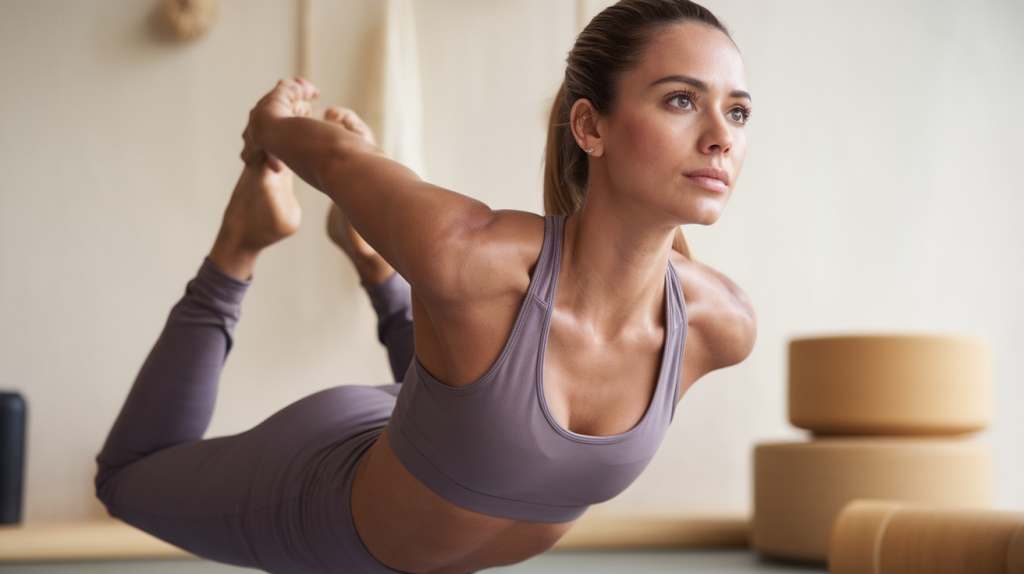
Yoga-inspired moves can indeed help flatten your stomach. These exercises combine strength, flexibility, and balance, engaging your core muscles in unique ways. Let’s explore five effective yoga-inspired moves that can contribute to a flatter tummy.
Boat pose
Boat pose, or Navasana in Sanskrit, is a powerful core strengthener. It targets your abdominal muscles, hip flexors, and lower back.
To perform boat pose:
- Sit on the floor with your knees bent
- Lean back slightly, keeping your spine straight
- Lift your feet off the ground, balancing on your sit bones
- Extend your arms forward, parallel to the ground
- If possible, straighten your legs to form a V-shape with your body
Hold this position for 30 seconds to 1 minute, or as long as you can maintain good form. As you progress, try to increase the duration of your hold.
Bird dog crunch
The bird dog crunch combines the stability challenge of the bird dog pose with the abdominal engagement of a crunch. This exercise works your entire core, including your obliques and lower back muscles.
Here’s how to do it:
- Start on your hands and knees in a tabletop position
- Extend your right arm forward and left leg back
- Bring your right elbow and left knee to meet under your body
- Extend back out to the starting position
- Repeat on the other side
Aim for 10-15 repetitions on each side. Focus on keeping your movements slow and controlled to maximize core engagement.
Three-legged dog to knee-to-nose
This dynamic move combines the benefits of downward-facing dog with a challenging core exercise. It improves flexibility in your hamstrings and back while also working your abs.
Follow these steps:
- Start in downward-facing dog position
- Lift your right leg high behind you
- Round your back and bring your right knee towards your nose
- Extend back to three-legged dog
- Repeat 5-10 times, then switch legs
As you perform this exercise, concentrate on using your core muscles to pull your knee towards your nose, rather than relying on momentum.
Forearm plank with alternating leg lifts
This variation on the traditional plank adds an extra challenge for your core and helps improve balance. It also engages your glutes and lower back muscles.
To perform this exercise:
- Start in a forearm plank position
- Keeping your hips level, lift your right leg a few inches off the ground
- Hold for a moment, then lower and lift your left leg
- Continue alternating legs for 30-60 seconds
Remember to keep your core tight and avoid letting your hips sag or rotate as you lift each leg.
Warrior III balance
Warrior III, or Virabhadrasana III, is an excellent pose for building core strength, improving balance, and toning your entire body.
Here’s how to do it:
- Stand on your right leg
- Hinge at your hips, lifting your left leg behind you
- Extend your arms forward, forming a T-shape with your body
- Keep your standing leg slightly bent and your hips level
- Hold for 30 seconds, then switch sides
As you hold this pose, focus on engaging your core to maintain balance and keep your body in a straight line from your fingertips to your raised foot.
These yoga-inspired moves offer a holistic approach to flattening your stomach. They not only work your abdominal muscles but also improve overall body awareness and posture, which can contribute to a flatter-looking midsection.
To get the most out of these exercises, try incorporating them into your routine 2-3 times a week. You can perform them as a standalone workout or integrate them into your existing yoga practice. As with any new exercise regimen, start slowly and gradually increase the duration and intensity as you build strength and confidence.
Remember, while these moves can help strengthen and tone your core muscles, achieving a flat stomach also depends on factors like overall body fat percentage and diet. Combining these exercises with a balanced nutrition plan and regular cardio can help you achieve your fitness goals more effectively.
Consistency is key when it comes to seeing results from any workout routine. By regularly practicing these yoga-inspired moves, you’ll not only work towards a flatter stomach but also improve your flexibility, balance, and overall body strength. This comprehensive approach to fitness can lead to long-lasting results and a greater sense of well-being.
Workout 5: HIIT for Maximum Ab Definition
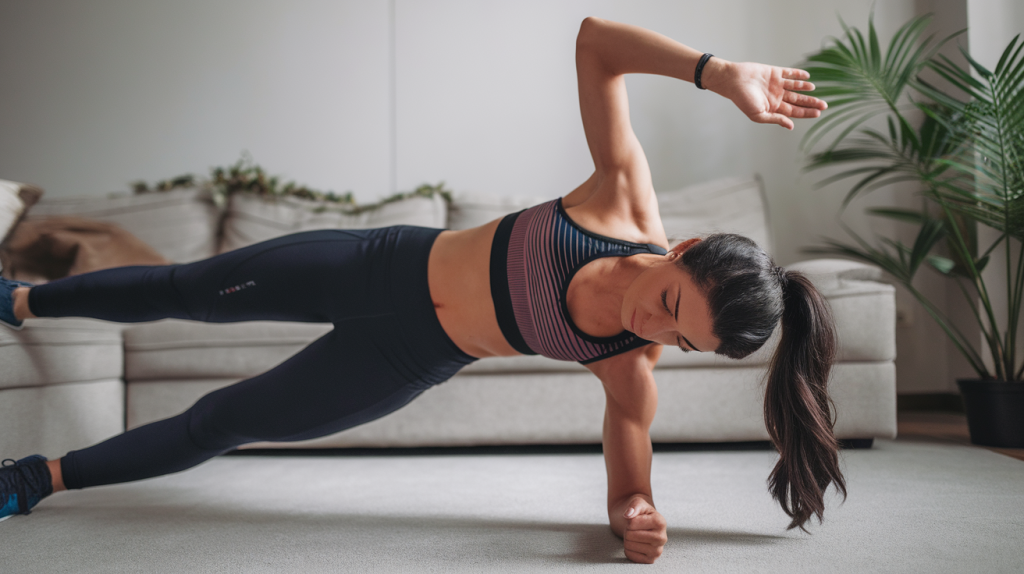
High-Intensity Interval Training (HIIT) is a powerful method for achieving maximum ab definition. This workout style alternates short bursts of intense exercise with brief recovery periods, pushing your body to its limits and accelerating fat burn. Let’s explore five HIIT exercises that can help you sculpt your abs and boost your overall fitness.
High knees
High knees are an excellent way to start your HIIT ab workout. This exercise engages your core while also providing a cardiovascular challenge.
To perform high knees:
- Stand with your feet hip-width apart
- Run in place, lifting your knees as high as possible
- Pump your arms as you run
- Keep your core tight throughout the movement
Perform this exercise for 30 seconds at maximum intensity, followed by a 10-second rest. Repeat for 3-4 rounds.
Plank taps
Plank taps combine the core-strengthening benefits of a plank with dynamic movement, intensifying the workout for your abs.
Here’s how to do plank taps:
- Start in a high plank position
- Keeping your hips stable, tap your right shoulder with your left hand
- Return to the starting position
- Tap your left shoulder with your right hand
- Continue alternating sides as quickly as possible while maintaining form
Aim for 40 seconds of work followed by 20 seconds of rest. Repeat this cycle 3-4 times.
Squat jumps with twist
This exercise targets your abs, glutes, and legs while also providing a cardio boost. The twisting motion particularly engages your obliques.
Follow these steps:
- Stand with feet shoulder-width apart
- Lower into a squat position
- Jump up explosively, twisting your body to the right in mid-air
- Land softly back in the squat position
- Repeat, alternating the direction of the twist with each jump
Perform squat jumps with twist for 30 seconds, then rest for 15 seconds. Complete 3-4 rounds.
Mountain climbers
Mountain climbers are a classic HIIT exercise that targets your entire core while also working your shoulders and hip flexors.
To do mountain climbers:
- Start in a high plank position
- Drive your right knee towards your chest
- Quickly switch legs, bringing your left knee in and extending your right leg back
- Continue alternating legs as if you’re running in place
Do this exercise for 45 seconds, followed by a 15-second rest. Repeat for 3-4 rounds.
Burpee tuck jumps
This challenging exercise combines a burpee with a tuck jump, providing a full-body workout with an emphasis on core engagement.
Here’s how to perform burpee tuck jumps:
- Start standing, then drop into a squat and place your hands on the floor
- Kick your feet back into a plank position
- Do a push-up (optional for added difficulty)
- Jump your feet back to your hands
- Instead of a regular jump, perform a tuck jump by bringing your knees towards your chest mid-air
- Land softly and immediately begin the next repetition
Due to the high-intensity nature of this exercise, perform it for 20 seconds, followed by 20 seconds of rest. Repeat for 3-4 rounds.
To create a complete HIIT ab workout, you can combine these exercises into a circuit. Perform each exercise for the specified work period, followed by the rest period, then move on to the next exercise. After completing all five exercises, take a 1-2 minute break, then repeat the circuit 2-3 more times.
Remember, the key to HIIT is maintaining high intensity during the work periods. Push yourself to perform each exercise as quickly and powerfully as you can while maintaining proper form. This approach not only targets your abs but also boosts your metabolism, leading to increased fat burn even after your workout is complete.
As with any high-intensity workout, it’s crucial to warm up properly before starting and cool down afterward. Start with a 5-minute warm-up of light cardio and dynamic stretching to prepare your body for the intense exercise to come.
Consistency is key when it comes to seeing results from HIIT workouts. Try to incorporate this ab-focused HIIT routine into your exercise regimen 2-3 times per week, allowing at least one day of rest between sessions to allow your muscles to recover and grow stronger.
By regularly practicing this HIIT workout, you’ll not only work towards maximum ab definition but also improve your overall cardiovascular fitness and endurance. Combined with a balanced diet and adequate rest, this workout can be a powerful tool in your journey towards a stronger, more defined core.
Sculpting Your Core: The Path to a Flatter Stomach
These five workouts offer a comprehensive approach to achieving a flatter stomach and stronger core. From plank variations and bodyweight exercises to dynamic moves, yoga-inspired poses, and high-intensity interval training, you now have a diverse set of tools to target your abs effectively. Each workout brings its own benefits, allowing you to mix and match based on your preferences and fitness level.
Remember, consistency is key when it comes to seeing results. Incorporate these workouts into your routine 2-3 times per week, and don’t forget the importance of a balanced diet in revealing those hard-earned abs. As you progress, challenge yourself by increasing the duration or intensity of the exercises. With dedication and perseverance, you’ll be well on your way to a stronger, more defined core and the flatter stomach you’ve been working towards.
Frequently Asked Questions
Q: How often should I do these ab workouts for best results?
A: Aim to incorporate these ab workouts into your routine 2-3 times per week, allowing at least one day of rest between sessions for muscle recovery.
Q: Can I achieve a flat stomach through exercise alone?
A: While exercise is crucial, achieving a flat stomach also depends on overall body fat percentage. Combine these workouts with a balanced diet for best results.
Q: Are planks really effective for strengthening the core?
A: Yes, planks are highly effective for core strengthening as they engage multiple muscle groups simultaneously, including the abs, back, and shoulders.
Q: How long should I hold a plank for maximum benefit?
A: Start with 30 seconds and gradually increase the duration as you build strength. Aim for 1-2 minutes for a challenging workout.
Q: Are yoga-inspired moves as effective as traditional ab exercises?
A: Yes, yoga-inspired moves can be very effective for core strengthening. They combine strength, flexibility, and balance, engaging your core in unique ways.
Q: What’s the advantage of HIIT for ab definition?
A: HIIT workouts boost metabolism and accelerate fat burn, helping to reveal ab muscles while also improving overall cardiovascular fitness.
Q: How long should a HIIT ab workout last?
A: A typical HIIT ab workout should last about 15-20 minutes, including warm-up and cool-down periods.
Q: Can beginners do these ab workouts?
A: Yes, beginners can start with modified versions of these exercises and gradually increase intensity as they build strength and improve form.
Q: How soon can I expect to see results from these ab workouts?
A: Results vary based on individual factors, but with consistent exercise and proper nutrition, you may start noticing changes in 4-8 weeks.

